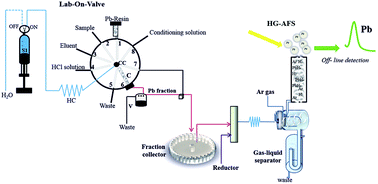Determination of lead by atomic fluorescence spectrometry using an automated extraction/pre-concentration flow system
Abstract
A multicommuted system has been developed for lead (Pb) isolation, pre-concentration and determination using an atomic fluorescence spectrometer as the detector. The lab-on-valve (LOV) technique allows automatic separation and pre-concentration of lead by means of solid phase extraction. The Pb resin was conditioned with nitric acid (1 mol L−1) and the analyte was eluted with 1.3 mol L−1 glycine solution. Chemical and flow variables affecting the extraction/pre-concentration of Pb2+ were investigated by a multivariate approach. First, screening of the independent variables and their interactions was carried out by a two level full factorial design (2k). Then, a face centered central composite design was performed in order to find the optimal values of the significant variables. Because a wide range of sample volumes can be loaded on the microcolumn (1–100 mL), a mass calibration curve was obtained in order to quantify Pb in sample batches with a wide variability in lead concentration. Under optimal conditions, the limit of detection and the quantification limit were 0.004 and 0.014 ng of Pb2+, respectively. The linear response range was 0.014–20 ng of Pb2+. The repeatability, expressed as relative standard deviation (RSD), is 2.4% for 4 μg L−1 Pb2+ (n = 10). A small amount (0.6 g) of Pb resin is enough to fill the microcolumn of the LOV device. The durability of the resin reached 154 injections. The injection frequency permitted between a sample frequency of 1–10 h−1 depending on the sample pre-concentration volume. This method was validated using certified reference materials such as SRM-1400 (bone ash), SRM-2976 (mussel tissue) and BCR-610 (groundwater), and the results obtained showed good agreement with the certified values. The proposed LOV system was successfully applied to different samples of environmental and biological interest (water, fish and human teeth) with satisfactory recoveries, between 90–110%. The proposed system has some advantages such as minimization of sample handling, sensitivity, good precision, reduction of reagent volumes, high durability of the column and the versatility achieved by a variety of managed sample volumes.


 Please wait while we load your content...
Please wait while we load your content...